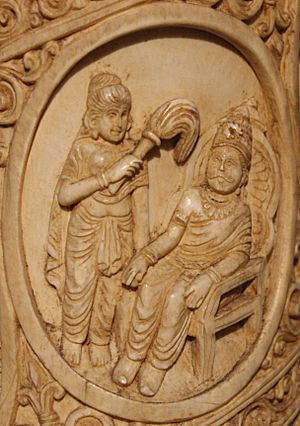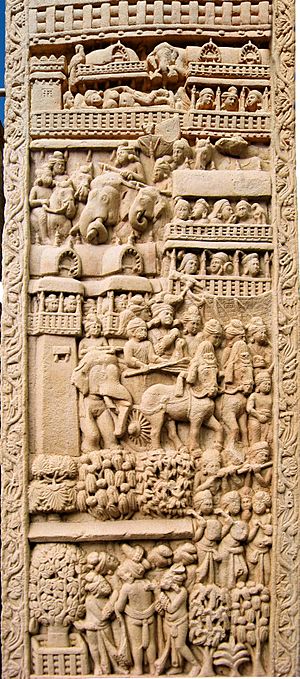Śuddhodana facts for kids
Quick facts for kids Śuddhodana |
|
|---|---|

Śuddhodana
|
|
| Predecessor | Sihahanu |
| Born | Kapilavastu, Shakya (The ancient city of Kapilavastu is believed to be either in present-day India or in present-day Nepal) |
| Died | Kapilavastu, Shakya |
| Wife | Maya Mahapajapati Gotami |
| Issue |
|
| House | Shakya |
| Father | Sihahanu |
| Mother | Kaccanā |
| Translations of Śuddhodana |
|
|---|---|
| Sanskrit | शुद्धोधन (Śuddhodana) |
| Pali | Suddhōdana |
| Burmese | သုဒ္ဓေါဒန (IPA: [θoʊʔdɔ́dəna̰]) |
| Khmer | សុទ្ធោទនៈ (Sotthoteakneak) |
| Sinhala | සුද්ධෝදන මහ រජතුමා |
| Thai | สุทโธทนะ (Sutthothana) |
| Glossary of Buddhism | |
Śuddhodana (meaning "he who grows pure rice") was an important leader of the Shakya people. The Shakya lived in an area of the Indian subcontinent called an oligarchic republic. This means it was ruled by a group of powerful people, not a single king. Their main city was Kapilavastu.
Śuddhodana is most famous for being the father of Siddhartha Gautama. Siddhartha later became known as The Buddha, a very important spiritual teacher. While some stories call Śuddhodana a king, many experts today believe he was more of a chosen leader.
Contents
Śuddhodana's Family Life
Śuddhodana's father was named Sihahanu, and his mother was Kaccanā.
His main wife was Maha Maya. They had a son named Siddhartha Gautama. Siddhartha later became known as the Buddha. Sadly, Maya passed away soon after Siddhartha was born.
After Maya's death, Śuddhodana married her sister, Mahapajapati Gotami. With Mahapajapati, he had another son named Nanda and a daughter named Sundarī Nandā. Both Nanda and Sundarī Nandā later became Buddhist monks and nuns.
When Siddhartha was 16, he married his cousin, Yasodharā. She was the niece of both Maha Maya and Mahapajapati.
About Śuddhodana's Role
Was Śuddhodana a King?
Many stories describe Śuddhodana as a king. However, most modern historians and scholars believe he was not a king in the way we usually think of one. The Shakya people lived in an oligarchy. This means a group of important leaders, often from the warrior or government class, made decisions together. They would choose a leader, called a rājā.
Even though the rājā had a lot of power, he didn't rule alone. Important decisions were discussed by the council, and everyone had to agree. Also, by the time Siddhartha was born, the Shakya republic was part of a larger kingdom called Kosala. The leader of the Shakya council needed the approval of the King of Kosala to stay in power.
The oldest Buddhist writings don't call Śuddhodana or his family "royals." Later texts might have misunderstood the word rājā. This word can mean a king, a prince, a ruler, or a governor. Some experts also believe that certain stories about the Buddha's life were added later.
Siddhartha's Journey to Enlightenment
Siddhartha Gautama was born in a place called Lumbini. He grew up in the Shakya capital city of Kapilavastu. Legend says that Śuddhodana tried very hard to stop Siddhartha from becoming a spiritual seeker.
However, when Siddhartha was 29, he saw four important sights that changed his life. These sights showed him suffering, old age, sickness, and death. After seeing these, Siddhartha left his home to find answers about life's challenges. He left behind his wife, Yasodharā, and his baby son, Rāhula. This event is known as The Great Renunciation.
Śuddhodana's Later Life
Śuddhodana was very sad when his son left. He spent a lot of time trying to find him. Seven years later, he heard that Siddhartha had become enlightened and was now the Buddha. Śuddhodana sent nine groups of people to invite Siddhartha back home. The Buddha taught these people, and they decided to join the Sangha (the community of Buddhist monks and nuns).
Then, Śuddhodana sent Kaludayi, a close friend of Siddhartha, to invite him. Kaludayi also chose to become a monk, but he kept his promise and invited the Buddha back. The Buddha accepted and visited his home. During this visit, he taught his father about the dharma (Buddhist teachings).
Four years later, the Buddha heard that Śuddhodana was close to death. He returned home again and taught Śuddhodana on his deathbed. Through these teachings, Śuddhodana achieved Arahantship, which means he reached a high level of spiritual understanding.
See also
 In Spanish: Śuddhodana para niños
In Spanish: Śuddhodana para niños


